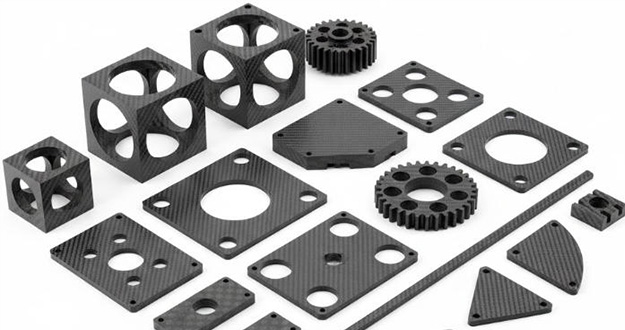Carbon fiber is a lightweight, high-strength composite material composed of carbon atoms arranged in a crystalline structure. Its unique combination of stiffness, strength, and corrosion resistance makes it widely used in aerospace, medical, automotive, and industrial components. Due to its layered structure and susceptibility to wear, carbon fiber processing requires specialized techniques and tools to maintain precision and part quality.
Let’s explore how carbon fiber machining works and how CNC machining helps you unlock its full potential.
What Is Carbon Fiber and How Is It Made?
Carbon fiber is made by heating polyacrylonitrile (PAN) or pitch-based fibers at high temperatures until they carbonize. The result is a fiber bundle with exceptional carbon fiber strength and low weight. These fibers are woven into fabrics or pressed into carbon fiber sheet structures, which can then be shaped into various forms. During production, the balance between carbon fiber strain and tensile strength determines its performance in demanding applications.
Why Choose Carbon Fiber for CNC Machining?
Choosing cnc machining carbon fiber ensures you achieve parts with an extraordinary strength-to-weight ratio. The rigidity and stability of the material make it perfect for precision components where microns count. Compared to metals like aluminum or titanium, carbon fiber offers superior vibration damping and fatigue resistance. For components requiring fine tolerances, carbon fiber cnc machining delivers consistent quality while maintaining a premium appearance.
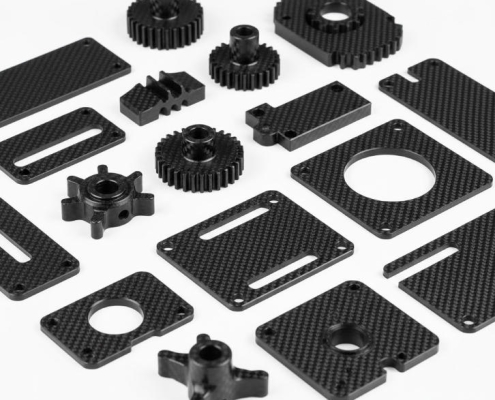
Carbon Fiber Tools for Machining
When machining carbon fiber, choosing the right tools is crucial for achieving precision, safety, and long tool life.
1.Tool Material
Carbon fiber is extremely abrasive, so ordinary cutting tools wear out very quickly. Using diamond-coated or solid carbide tools is essential. These materials are designed to resist wear, maintain sharpness, and handle repeated cuts without degrading, which ensures consistent performance and reduces the frequency of tool replacement.
2. Tool Geometry
The shape and angles of the cutting tool play a big role in machining carbon fiber. Tools with optimized cutting geometry help reduce fraying and delamination of the fibers. They also minimize heat buildup, which can otherwise burn or weaken the material. Correct tool geometry ensures cleaner cuts and prolongs the life of both the tool and the workpiece.
3. Sharpness and Precision
Maintaining sharp cutting edges is critical for smooth, precise machining. Dull tools can tear fibers, create rough surfaces, and produce more dust. Using balanced tool holders also reduces vibration, which improves surface finish and maintains dimensional accuracy. This is especially important in high-precision parts where even small deviations can cause issues.
4. CNC Settings
Proper tool paths and tool compensation settings in CNC machines are vital for working with carbon fiber. Correctly programmed paths prevent splintering and uneven cuts, ensuring that the final product matches design specifications. Tool compensation allows for adjustments that maintain accuracy as tools wear, further improving quality and reducing waste.
5. Additional Tips
For optimal results, use high spindle speeds combined with moderate feed rates. Always ensure dust extraction or proper ventilation, because carbon fiber dust is harmful to inhale and can damage machinery. Some machinists also use compressed air or other cooling methods to prevent overheating, as carbon fiber does not conduct heat well and can scorch if the cutting area becomes too hot.
Advantages of CNC Machining Carbon Fiber
Carbon fiber is known for its high strength, low weight, and excellent resistance to corrosion and heat. When combined with CNC machining, these natural advantages are fully utilized to create precise, durable, and lightweight components.
1. High Precision and Accuracy
CNC machining allows for precise shaping of carbon fiber parts. The computer-controlled system ensures tight tolerances and repeatable accuracy, widely used in aerospace, automotive, and medical products.
2. Smooth Surface Finish
Carbon fiber has a naturally sleek texture. When machined correctly, CNC cutting produces clean edges and smooth surfaces with very little fraying or fiber damage. This improves both appearance and performance.
3. Lightweight and Strong
Carbon fiber offers an excellent strength-to-weight ratio. CNC machining helps maintain this property, producing parts that are both tough and extremely light.
4. Corrosion and Heat Resistance
Unlike metals, carbon fiber does not rust or corrode. It also performs well under high temperatures. CNC-machined carbon fiber components remain stable and reliable even in harsh environments.
5. Design Flexibility
CNC machining makes it easy to produce both simple and complex designs. Engineers can modify CAD files quickly and machine different shapes, from thin panels to curved surfaces, without changing the entire setup.
6. Reduced Material Waste
Since carbon fiber is expensive, efficient material use is important. CNC machining follows precise tool paths, which helps reduce waste and lower overall production costs.
7. Consistent Quality
Once programmed, CNC machines can produce identical carbon fiber parts again and again. This ensures consistent dimensions and surface quality across every batch.
8. Fast Prototyping and Customization
CNC machining allows for rapid prototyping of new carbon fiber designs. It supports quick adjustments and small production runs, making it perfect for testing or custom projects.
Challenges of CNC Machining Carbon Fiber
Machining carbon fiber can be tricky. The main challenges are delamination, excessive tool wear, and dust management. Because it is brittle and abrasive, it can damage standard cutting tools.
| Challenge | Cause | Recommended Solution |
|---|---|---|
| Delamination | Too high feed rate or improper cutting angles | Use diamond-coated or carbide tools, optimize feed and speed, maintain proper tool geometry |
| Tool wear | Abrasive fibers | Use diamond-coated or carbide tools, regularly replace tools, monitor wear |
| Dust issues | Fine particle generation | Install vacuum extraction system, wear respiratory protection, maintain workspace cleanliness |
| Fiber pullout | Dull tools or incorrect spindle speed | Use sharp tools, adjust spindle speed and feed rate, ensure proper tool geometry |
| Surface roughness | Vibration or imbalance | Use balanced tool holders, reduce vibration, apply proper tool clamping and fixturing |
| Heat buildup | High cutting speed or low feed | Reduce cutting speed, increase feed rate, consider air or compressed air cooling |
| Material wastage | Incorrect tool path or programming errors | Plan accurate tool paths, verify CNC programs, perform trial runs on scrap material |
| Health hazards | Inhalation of carbon dust | Use dust masks or respirators, proper ventilation, and dust collection systems |
Surface Finishing and Protection for Carbon Fiber Parts
Surface finishing is essential to make your carbon fiber parts smooth, strong, and long-lasting. After cnc machining carbon fiber, the surface may have small burrs or exposed fibers. Sealing the edges and adding a clear protective coating help prevent moisture, cracks, and wear.
For a shiny, high-end look like a smartphone, polishing or applying a glossy coating brings out the weave of the carbon fiber material. If you prefer a functional or non-reflective surface, a light matte sanding or bead blasting works better. These finishes not only improve appearance but also enhance performance and durability.
At VMT, every custom cnc machining carbon fiber part goes through careful post-processing, including cleaning, coating, and inspection. This ensures your carbon fiber components look professional, fit perfectly, and last longer in any environment.
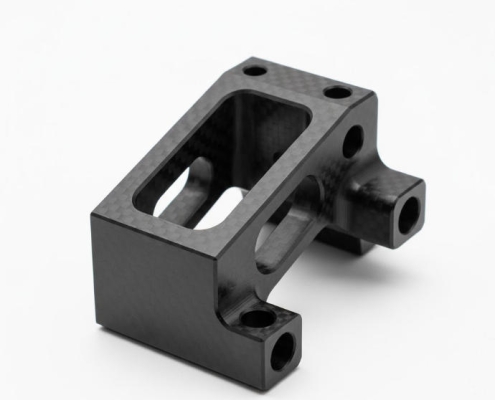
Applications of CNC Machining Carbon Fiber Parts
CNC machined carbon fiber parts are used in many industries that demand high performance, strength, and low weight. The precision of CNC machining allows engineers to create parts that meet strict design and functional requirements. Here are some of the most common applications:
1. Aerospace and Aviation
Carbon fiber components are widely used in aircraft structures such as brackets, panels, ducts, and control surfaces. Their lightweight nature helps reduce overall aircraft mass, improving fuel efficiency and flight range while maintaining excellent strength and stiffness.
2. Automotive and Motorsports
In high-performance and racing vehicles, carbon fiber CNC parts are used for body panels, interior trims, chassis components, and aerodynamic parts. The material’s light weight and high strength enhance speed, handling, and fuel efficiency.
3. Medical Equipment
Carbon fiber, due to its non-magnetic and radiolucent properties, has become the material of choice for medical imaging housings, prosthetic components, and surgical instruments. Through CNC machining, each component achieves the precision and smoothness necessary for performance and reliability in the medical field.
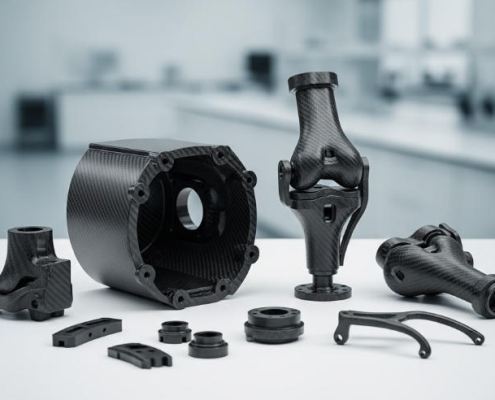
4. Electronics and Consumer Devices
Carbon fiber’s rigidity, heat resistance, and modern appearance make it suitable for laptop covers, drone frames, electronic casings, and protective housings. CNC machining allows for accurate cutouts for ports, connectors, and ventilation.
5. Robotics and Industrial Automation
In robotic arms, machine frames, and automation systems, CNC machining carbon fiber parts help reduce moving mass, resulting in faster motion and better energy efficiency while maintaining structural stability.
Best Practices for CNC Machining Carbon Fiber
Working with carbon fiber requires precision and care. Begin with stable fixturing and dry machining to protect the fiber structure. Set moderate spindle speeds and low feed rates to prevent heat buildup or delamination. A vacuum system or sealed enclosure keeps the workspace clean and safe from fine carbon dust.
Advanced 4-axis and 5-axis CNC machines allow complex shapes to be formed while maintaining the integrity of each fiber layer. For high-precision parts, hold tolerances within ±0.01 mm and confirm accuracy with CMM inspection. Every detail matters when the goal is a flawless finish.
VMT combines decades of machining experience with the perfect blend of technology and craftsmanship. With over 100 precision machine tools and rigorous process controls, VMT ensures that every carbon fiber part you produce complies with ISO 9001, IATF 16949, and SGS standards. From prototype to mass production, its in-line CNC machining services transform your ideas into reality quickly, accurately, and reliably.
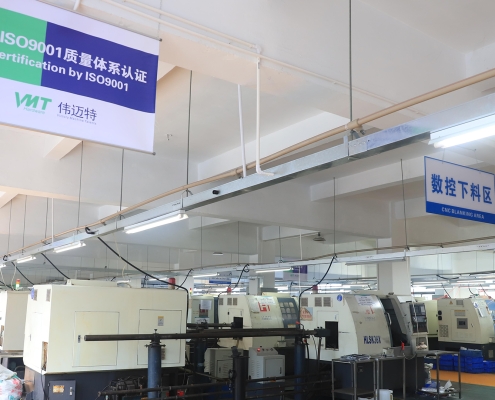
In Conclusion
When you choose cnc machining carbon fiber, you’re investing in a material that combines the strength of steel with the lightness of plastic. Its superior strength, excellent dimensional stability and inherent corrosion resistance make it the first choice for industries that demand precision and performance. With professional expertise, advanced 5-axis machines, and tailored custom cnc machining carbon fiber solutions from VMT, you can bring complex ideas to life.
Frequently Asked Questions
What Is So Special About Carbon Fiber?
Carbon fiber is a unique material made mostly of carbon atoms bonded in long chains. Its main features are extreme strength, lightweight, stiffness, corrosion resistance, and low thermal expansion. These properties make it ideal for applications where traditional metals or plastics cannot meet the demands.
Is Carbon Fiber Stronger Than Steel?
Yes, carbon fiber can be stronger than steel by weight. While steel may have higher absolute tensile strength, carbon fiber’s strength-to-weight ratio is far superior, meaning it can carry comparable or greater loads while being much lighter. This is why it’s widely used in aerospace, automotive, and sports equipment.
What Is Carbon Fiber Used For?
Carbon fiber is used wherever high strength, low weight, and precision are required. Common applications include:
Aerospace: aircraft panels, brackets, and satellite components
Automotive and Motorsports: body panels, chassis parts, and aerodynamic components
Sports Equipment: bicycles, tennis rackets, golf clubs
Medical Devices: prosthetics, imaging housings, and surgical instruments
Electronics: protective casings and drone frames
Is Carbon Fiber Expensive?
Yes, carbon fiber is generally more expensive than conventional materials like steel or aluminum. The cost comes from raw material production, complex manufacturing, and precision machining requirements. However, its benefits in weight reduction, performance, and durability often justify the higher cost, especially in high-performance or specialized applications.

